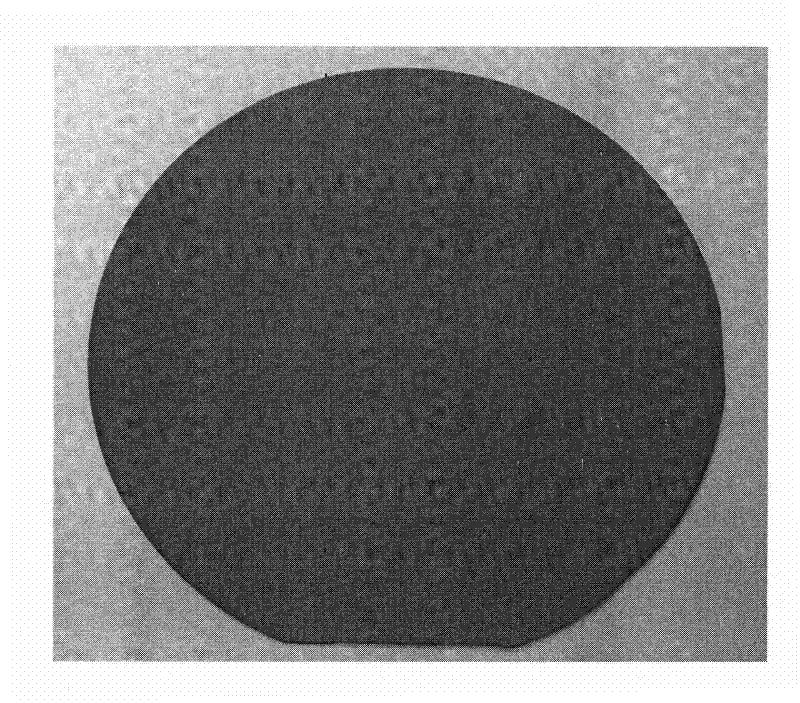Method for processing lithium niobate or lithium tantalate wafer
A technology of lithium tantalate and lithium niobate, applied in the field of processing lithium niobate or lithium tantalate wafers, can solve the problems of hydrogen explosion, difference in reduction degree of wafers, depolarization, etc. The effect of weakening the effect and increasing the conductivity
- Summary
- Abstract
- Description
- Claims
- Application Information
AI Technical Summary
Problems solved by technology
Method used
Image
Examples
Embodiment 1
[0017] First the lithium niobate wafer to be processed is placed in a corundum crucible suitable for the wafer size, and iron powder and lithium carbonate powder (the mass ratio of iron powder in the mixed system is 5% in the mixed system, wherein lithium carbonate The purity of the corundum powder is 4N, and the specification of iron powder is 500 mesh), and then the corundum crucible is placed in a heat treatment furnace, and the temperature is raised to a holding temperature of 450°C under a nitrogen atmosphere with a flow rate of 0.5L / min. Heat treatment at lower temperature for 3 hours, then lower to room temperature and take out the wafer. The prepared lithium niobate wafer is gray, as figure 1 Shown; volume resistivity at 10 12 Ω·cm order of magnitude.
Embodiment 2
[0019] First the lithium niobate wafer to be processed is placed in a corundum crucible suitable for the wafer size, and iron powder and lithium carbonate powder (the mass ratio of iron powder in the mixed system is 6% in the mixed system, wherein lithium carbonate The purity of the corundum powder is 4N, and the specification of iron powder is 500 meshes) into the crucible to completely cover the wafer, then place the corundum crucible in a heat treatment furnace, and raise the temperature to a holding temperature of 480°C under a nitrogen atmosphere with a flow rate of 0.6L / min Heat treatment at lower temperature for 5 hours, then drop to room temperature and take out the wafer. The prepared lithium niobate wafer was dark gray, as figure 2 Shown; volume resistivity at 10 11 Ω·cm order of magnitude.
Embodiment 3
[0021] First the lithium niobate wafer to be processed is placed in a corundum crucible suitable for the wafer size, and iron powder and lithium carbonate powder (the mass ratio of iron powder in the mixed system is 8% in the mixed system, wherein lithium carbonate The purity of the corundum powder is 4N, and the specification of the iron powder is 500 mesh) into the crucible to completely cover the wafer, then place the corundum crucible in a heat treatment furnace, and raise the temperature to a holding temperature of 510°C under a nitrogen atmosphere with a flow rate of 0.8L / min Heat treatment under lower temperature for 8 hours, then drop to room temperature and take out the wafer. The prepared lithium niobate wafers appear black, such as image 3 Shown; volume resistivity at 10 10 Ω·cm order of magnitude.
PUM
| Property | Measurement | Unit |
|---|---|---|
| electrical resistivity | aaaaa | aaaaa |
| electrical resistivity | aaaaa | aaaaa |
| electrical resistivity | aaaaa | aaaaa |
Abstract
Description
Claims
Application Information
 Login to View More
Login to View More - R&D
- Intellectual Property
- Life Sciences
- Materials
- Tech Scout
- Unparalleled Data Quality
- Higher Quality Content
- 60% Fewer Hallucinations
Browse by: Latest US Patents, China's latest patents, Technical Efficacy Thesaurus, Application Domain, Technology Topic, Popular Technical Reports.
© 2025 PatSnap. All rights reserved.Legal|Privacy policy|Modern Slavery Act Transparency Statement|Sitemap|About US| Contact US: help@patsnap.com



